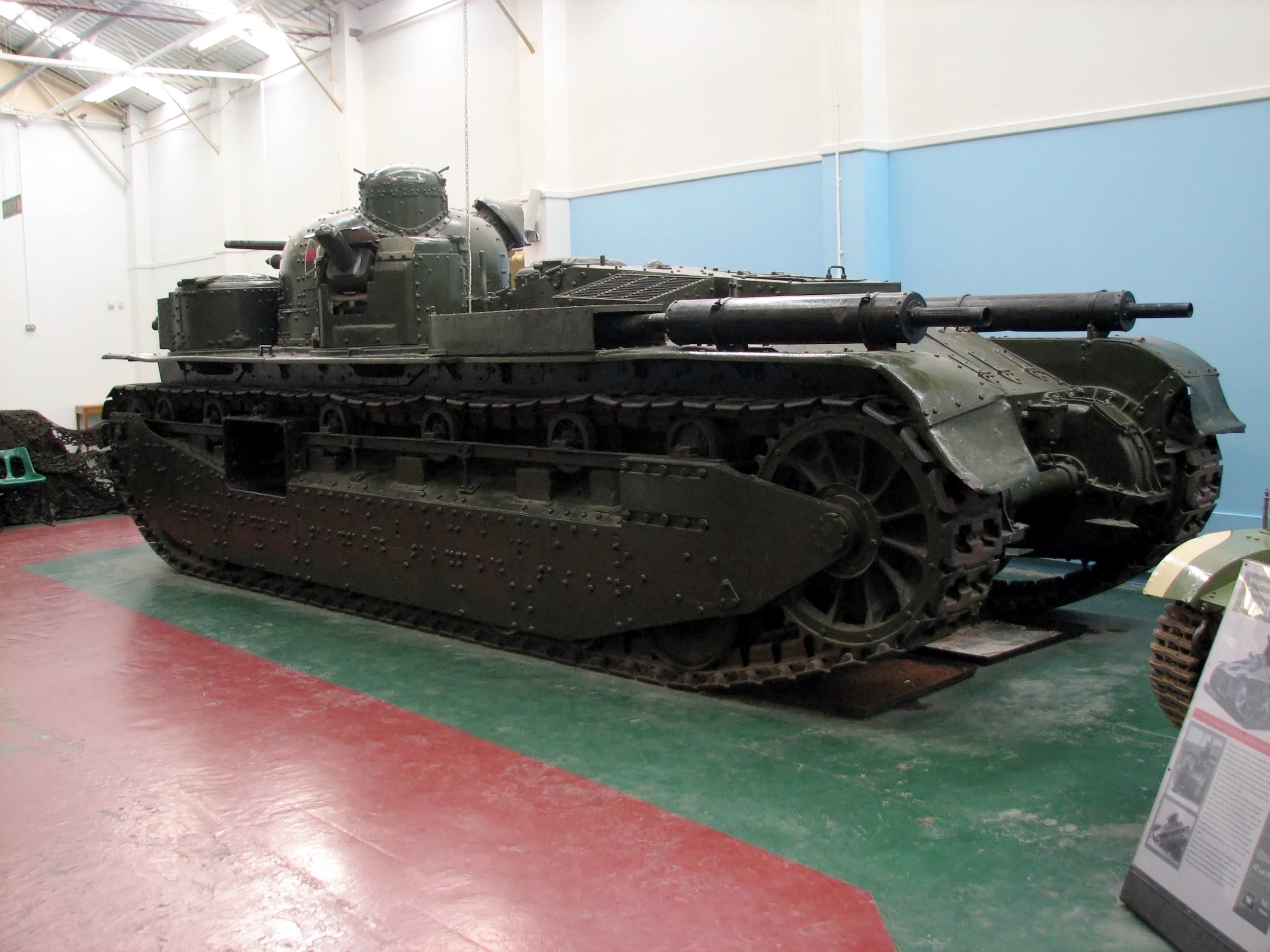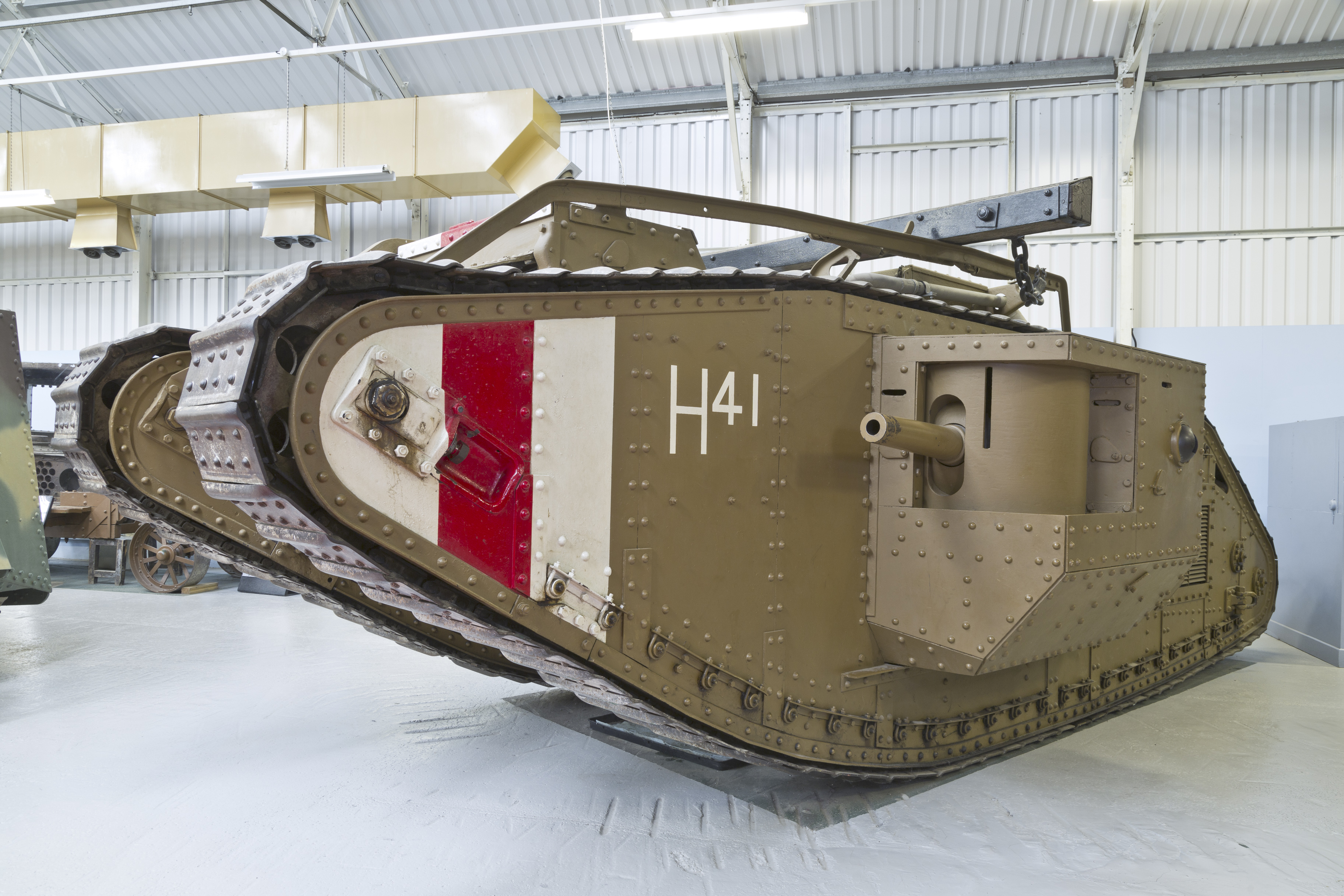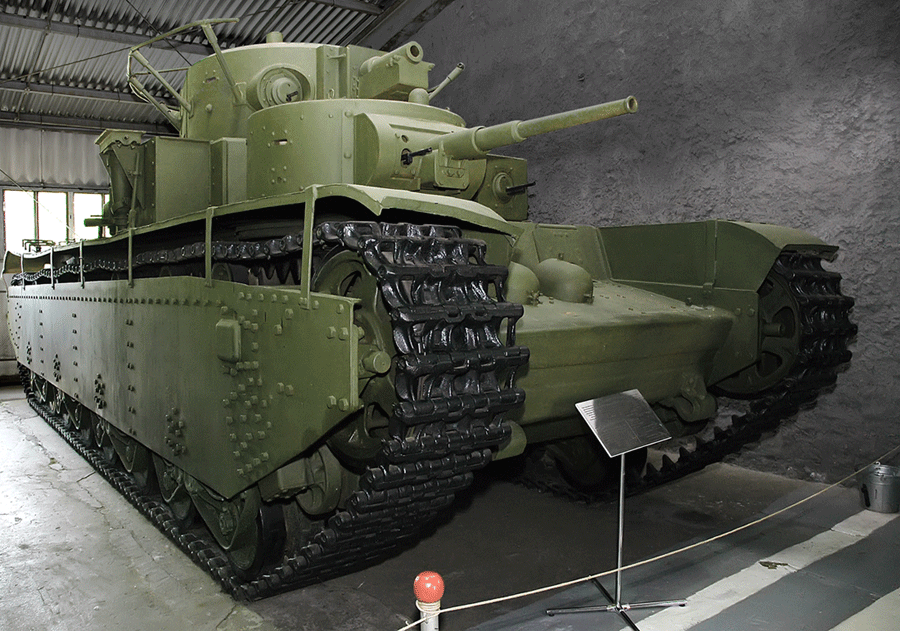|
Vickers Independent A1E1 Tank
The Independent A1E1 is a multi-turreted tank that was designed by the British armaments manufacturer Vickers between the First and Second World Wars. Although it only ever reached the prototype stage and only a single example was built, it influenced many other tank designs. The A1E1 design can be seen as a possible influence on the Soviet T-100 and T-28 tanks, the German ''Neubaufahrzeug'' tanks, and the British Medium Mk III and Cruiser Mk I (triple turret) tank designs. The Soviet T-35 tank was heavily influenced by its design. Design The Independent was a multi-turret design, having a central gun turret armed with the 3 pounder (47 mm) gun, and four subsidiary turrets each armed with a 0.303 inch Vickers machine gun. The subsidiary turrets were mounted two at the front and two to the rear of the turret (about halfway along the hull). The gun of the left rear turret was able to elevate to engage aircraft. The tank was designed to have heavy firepower, self-defence capa ... [...More Info...] [...Related Items...] OR: [Wikipedia] [Google] [Baidu] |
Vickers
Vickers was a British engineering company that existed from 1828 until 1999. It was formed in Sheffield as a steel foundry by Edward Vickers and his father-in-law, and soon became famous for casting church bells. The company went public in 1867, acquired more businesses, and began branching out into military hardware and shipbuilding. In 1911, the company expanded into aircraft manufacturer, aircraft manufacture and opened a flying school. They expanded even further into electrical and railway manufacturing, and in 1928 acquired an interest in the Supermarine. Beginning in the 1960s, various parts of the company were nationalised, and in 1999 the rest of the company was acquired by Rolls-Royce Holdings, Rolls-Royce plc, who sold the defence arm to Alvis plc. The Vickers name lived on in Alvis Vickers, until the latter was acquired by BAE Systems in 2004 to form BAE Systems Platforms & Services, BAE Systems Land Systems. History Early history Vickers was formed in Sheffield ... [...More Info...] [...Related Items...] OR: [Wikipedia] [Google] [Baidu] |
Germany
Germany,, officially the Federal Republic of Germany, is a country in Central Europe. It is the second most populous country in Europe after Russia, and the most populous member state of the European Union. Germany is situated between the Baltic and North seas to the north, and the Alps to the south; it covers an area of , with a population of almost 84 million within its 16 constituent states. Germany borders Denmark to the north, Poland and the Czech Republic to the east, Austria and Switzerland to the south, and France, Luxembourg, Belgium, and the Netherlands to the west. The nation's capital and most populous city is Berlin and its financial centre is Frankfurt; the largest urban area is the Ruhr. Various Germanic tribes have inhabited the northern parts of modern Germany since classical antiquity. A region named Germania was documented before AD 100. In 962, the Kingdom of Germany formed the bulk of the Holy Roman Empire. During the 16th ce ... [...More Info...] [...Related Items...] OR: [Wikipedia] [Google] [Baidu] |
Interwar Tanks Of The United Kingdom
In the history of the 20th century, the interwar period lasted from 11 November 1918 to 1 September 1939 (20 years, 9 months, 21 days), the end of the First World War to the beginning of the Second World War. The interwar period was relatively short, yet featured many significant social, political, and economic changes throughout the world. Petroleum-based energy production and associated mechanisation led to the prosperous Roaring Twenties, a time of both social mobility and economic mobility for the middle class. Automobiles, electric lighting, radio, and more became common among populations in the developed world. The indulgences of the era subsequently were followed by the Great Depression, an unprecedented worldwide economic downturn that severely damaged many of the world's largest economies. Politically, the era coincided with the rise of communism, starting in Russia with the October Revolution and Russian Civil War, at the end of World War I, and ended with the rise o ... [...More Info...] [...Related Items...] OR: [Wikipedia] [Google] [Baidu] |
The Tank Museum
The Tank Museum (previously The Bovington Tank Museum) is a collection of armoured fighting vehicles at Bovington Camp in Dorset, South West England. It is about north of the village of Wool and west of the major port of Poole. The collection traces the history of the tank. With almost 300 vehicles on exhibition from 26 countries it is the largest collection of tanks and the third largest collection of armoured vehicles in the world.The ''Musée des Blindés'' in France has a collection of 880 armoured vehicles, although it includes fewer tanks than Bovington. It includes Tiger 131, the only working example of a German Tiger I tank, and a British First World War Mark I, the world's oldest surviving combat tank. It is the museum of the Royal Tank Regiment and the Royal Armoured Corps and is a registered charity. History The writer Rudyard Kipling visited Bovington in 1923 and, after viewing the damaged tanks that had been salvaged at the end of the First World War, recommended ... [...More Info...] [...Related Items...] OR: [Wikipedia] [Google] [Baidu] |
Norman Baillie-Stewart
Norman Baillie-Stewart (15 January 1909 – 7 June 1966) was a British army officer known as The Officer in the Tower when he was imprisoned in the Tower of London. An active sympathiser of Nazi Germany, he took part in German-produced propaganda broadcasts and is known as one of the men associated with the nickname Lord Haw-Haw. Early life Baillie-Stewart's father was Lieutenant Colonel Cron Hope Baillie Wright, an officer in the British Indian Army who served in the 62nd Punjabis during the First World War. His mother was from a family with a long tradition of military service. Baillie-Stewart attended Bedford School and the Royal Military College, Sandhurst, where as a cadet, he served as an orderly to Prince Henry, a younger son of King George V. In January 1929, still a cadet, he changed his surname from Wright to Baillie-Stewart, perhaps under the belief that he was looked down upon by more senior officers. He graduated tenth in the order of merit and in February 1929 r ... [...More Info...] [...Related Items...] OR: [Wikipedia] [Google] [Baidu] |
War Office
The War Office was a department of the British Government responsible for the administration of the British Army between 1857 and 1964, when its functions were transferred to the new Ministry of Defence (MoD). This article contains text from this source, which is available under th Open Government Licence v3.0 © Crown copyright It was equivalent to the Admiralty, responsible for the Royal Navy (RN), and (much later) the Air Ministry, which oversaw the Royal Air Force (RAF). The name 'War Office' is also given to the former home of the department, located at the junction of Horse Guards Avenue and Whitehall in central London. The landmark building was sold on 1 March 2016 by HM Government for more than £350 million, on a 250 year lease for conversion into a luxury hotel and residential apartments. Prior to 1855, 'War Office' signified the office of the Secretary at War. In the 17th and 18th centuries, a number of independent offices and individuals were re ... [...More Info...] [...Related Items...] OR: [Wikipedia] [Google] [Baidu] |
Air-cooled
Air-cooled engines rely on the circulation of air directly over heat dissipation fins or hot areas of the engine to cool them in order to keep the engine within operating temperatures. In all combustion engines, a great percentage of the heat generated (around 44%) escapes through the exhaust, not through the metal fins of an air-cooled engine (12%). About 8% of the heat energy is transferred to the oil, which although primarily meant for lubrication, also plays a role in heat dissipation via a cooler. ''Air-cooled engines'' are used generally in applications which would not suit liquid cooling, as such modern air-cooled engines are used in motorcycles, general aviation aircraft, lawn mowers, generators, outboard motors, pump sets, saw benches and auxiliary power units. Introduction Most modern internal combustion engines are cooled by a closed circuit carrying liquid coolant through channels in the engine block and cylinder head, where the coolant absorbs heat, to a heat ... [...More Info...] [...Related Items...] OR: [Wikipedia] [Google] [Baidu] |
Walter Gordon Wilson
Major Walter Gordon Wilson (21 April 1874 – 1 July 1957) was an Irish mechanical engineer, inventor and member of the British Royal Naval Air Service. He was credited by the 1919 Royal Commission on Awards to Inventors as the co-inventor of the tank, along with Sir William Tritton. Education Walter was born in Blackrock, County Dublin, on 21 April 1874. In 1888 he enlisted as a midshipman on HMS ''Britannia'', but resigned in 1892. In 1894 he entered King's College, Cambridge, where he studied the mechanical sciences tripos, graduating with a first class degree, B.A., in 1897. Wilson acted as 'mechanic' for the Hon C. S. Rolls on several occasions while they were undergraduates in Cambridge. Aero engine 1898 Interested in powered flight, he collaborated with Percy Sinclair Pilcher and the Hon Adrian Verney-Cave later Lord Braye to attempt to make an aero-engine from 1898. The engine was a flat-twin air cooled and weighed only 40 lb, but shortly before a demonstration ... [...More Info...] [...Related Items...] OR: [Wikipedia] [Google] [Baidu] |
British Army
The British Army is the principal land warfare force of the United Kingdom, a part of the British Armed Forces along with the Royal Navy and the Royal Air Force. , the British Army comprises 79,380 regular full-time personnel, 4,090 Gurkhas, and 28,330 volunteer reserve personnel. The modern British Army traces back to 1707, with antecedents in the English Army and Scots Army that were created during the Restoration in 1660. The term ''British Army'' was adopted in 1707 after the Acts of Union between England and Scotland. Members of the British Army swear allegiance to the monarch as their commander-in-chief, but the Bill of Rights of 1689 and Claim of Right Act 1689 require parliamentary consent for the Crown to maintain a peacetime standing army. Therefore, Parliament approves the army by passing an Armed Forces Act at least once every five years. The army is administered by the Ministry of Defence and commanded by the Chief of the General Staff. The Brit ... [...More Info...] [...Related Items...] OR: [Wikipedia] [Google] [Baidu] |
General Staff
A military staff or general staff (also referred to as army staff, navy staff, or air staff within the individual services) is a group of officers, enlisted and civilian staff who serve the commander of a division or other large military unit in their command and control role through planning, analysis, and information gathering, as well as by relaying, coordinating, and supervising the execution of their plans and orders, especially in case of multiple simultaneous and rapidly changing complex operations. They are organised into functional groups such as administration, logistics, operations, intelligence, training, etc. They provide multi-directional flow of information between a commanding officer, subordinate military units and other stakeholders.PK Mallick, 2011Staff System in the Indian Army: Time for Change Centre for Land Warfare Studies, New Delhi, vol 31. A centralised general staff results in tighter top-down control but requires larger staff at headquarters (HQ) ... [...More Info...] [...Related Items...] OR: [Wikipedia] [Google] [Baidu] |
Bovington 022 Independent 1
Bovington Camp () is a British Army military base in Dorset, England. Together with Lulworth Camp it forms part of Bovington Garrison. The garrison is home to The Armour Centre and contains two barracks complexes and two forest and heathland training areas that support Phase Two training for soldiers of the Royal Armoured Corps and trade training for the Household Cavalry Regiment as well as other armoured units. It also houses The Tank Museum on its property. It is run by the resident RSM W01 Joshua Wisdom History The camps at Bovington and Lulworth Camp, Lulworth were originally established in 1899 as an infantry training area and ranges. In 1916, they became training camps for the Heavy Branch of the Machine Gun Corps which relocated from Norfolk. The Heavy Branch was responsible for the operation of the tank in the British Army. In 1917 the Heavy Branch split from the Machine Gun Corps to become the Tank Corps, with the Depot and Central Schools being based at Bovington. I ... [...More Info...] [...Related Items...] OR: [Wikipedia] [Google] [Baidu] |
T-35
The T-35 was a Soviet multi- turreted heavy tank of the interwar period and early Second World War that saw limited production and service with the Red Army. Often called a land battleship, it was the only five-turreted heavy tank in the world to reach production, but proved to be slow and mechanically unreliable. Most of the T-35 tanks still operational at the time of Operation Barbarossa were lost due to mechanical failure rather than enemy action. It was designed to complement the contemporary T-28 medium tank; however, very few were built. Outwardly, it was large; but internally, the spaces were cramped with the fighting compartments separated from each other. Some of the turrets obscured the entrance hatches. Production history The T-35 was developed by the OKMO design bureau of the Bolshevik Factory, which began work on a heavy tank in 1930. Two teams developed separate designs. The team headed by German engineer Grotte worked on the 100-ton four-turreted TG-5 tank, ar ... [...More Info...] [...Related Items...] OR: [Wikipedia] [Google] [Baidu] |










